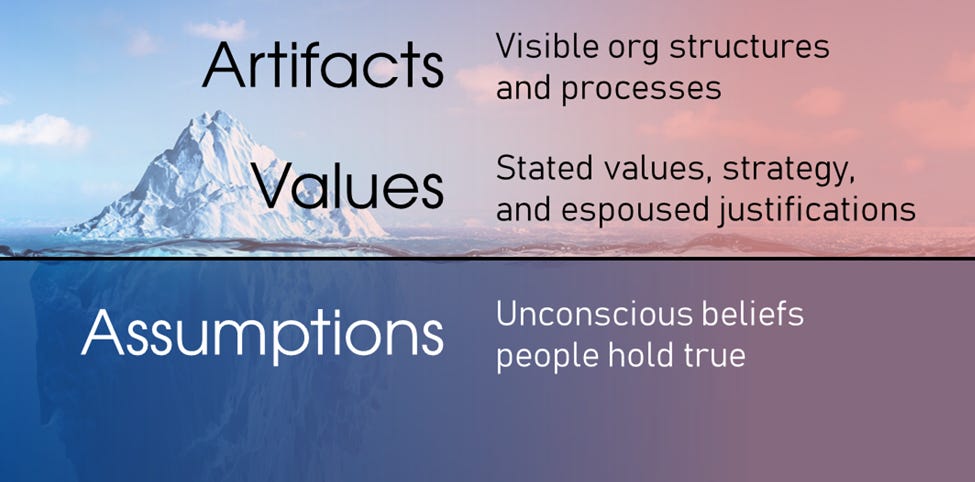Corporate culture is not as mysterious as people often make it out to be. To see this, however, we must first admit certain things leadership often does not want to admit. Chief among these—surprise, surprise—is what actually determines culture. Executives tend to treat culture as a sort of branding exercise, as something they can simply speak into existence.
This attempts to reduce culture to stated values, to the middle layer of Schein’s culture model. Schein’s pyramid strongly suggests an iceberg, with the actual assumptions at play lying “beneath the surface”. While useful as a sort of congruence check, this model doesn’t go far enough. After all, where do assumptions come from?
When asking a similar question on Twitter (er, I mean “X”), Matt Barcomb pointed me to the Results Pyramid. Googling this brought me to the book Propeller. Here, corporate culture is defined as the sum of the experiences, beliefs, and actions that enable an organization to achieve key results. Results are created by behavior, people take action informed by their beliefs, and their beliefs are largely driven by their real-world experience. Beneath assumptions, then, lies experience. This gets us closer, but we still need to go deeper. How do we change people’s experience?
My own preferred model is the Marxist concept of “base and superstructure”. The idea here is that culture and cultural byproducts are largely a manifestation of underlying economic realities and incentives. In this model, the “base” can be thought of a given power dynamic acting in the world, which influences and mixes with past superstructure to spin off new ideology, new “superstructure”, that then in turn reinforces the existing base. This ideology is, in a very real sense, the actual corporate culture (or corporate “mythology”), that both flows from and shores up the present base. The model is beautiful in its simplicity. It’s refreshing. And most of all, it’s honest.
People largely do what they are incentivized to do. This isn’t some earth-shattering revelation. We already know this—we just often act like we don’t. Consider for instance the famous Goldratt quote from The Haystack Syndrome: “Tell me how you measure me, and I will tell you how I will behave. If you measure me in an illogical way…do not complain about illogical behavior.” Or consider Deming’s oft-ignored 14 Points, which similarly highlight the extent to which actual culture stems from how performance reviews are handled.
Executives, however, do not like this. They want to keep culture change initiatives confined to superstructure, to things like narratives and values and branding, while they simultaneously role out their rating and ranking and forced distributions, pretending all the while that when they do so they are not also setting the culture. In short, they want culture change for free…but it doesn’t work that way. While dodging what determines culture and leading with what doesn’t, they simultaneously pretend the issue is “complex”.
With apologies to the Cynefin, saying something is “complex” is often just an excuse. The truth is that changing culture isn’t hard, as long as we can be honest about what culture is. What determines culture is: 1) what people are actually rewarded for; and 2) the perceived integrity of leaders, which depends on their behavior (not their messaging).
Borrowing from a model I originally learned from Accenture, this allows us to update our iceberg from above, improving upon the Schein pyramid and bringing it more in line with the concept of base and superstructure.
The deeper we go, the bigger the lever. When the lip service does not match actual incentives and leadership behavior, the organization is incongruent. As Gerald Weinberg put it, its “words and music don’t match”. And the vital point here is that the music dictates the culture, it’s the signal, and the words are often noise. When we get better at ignoring the words and finding the music, things get a whole lot simpler.
When executives pretend their superstructure branding is what determines culture, they assume they have some spell-casting power they do not actually possess. When they ignore this, they not only waste time and money on culture-change initiatives that are doomed to fail, but they tarnish their own reputations as well. Borrowing a concept from Senn Delaney, this incongruence casts a negative “shadow”. This darkens their reputation and creates a culture of drama and mistrust.
In conclusion, companies actually tell us loud and clear what their real culture is…when we listen to the music.
If a company incentivizes staying busy above increasing throughput, then it is telling us that in all honestly people staying busy is more important than throughput. That’s the culture.
If a company says it values agility while only rewarding velocity, then that’s the culture.
If a company claims it prizes innovation and fearless risk taking but punishes failure, then it’s a risk-averse culture, regardless of the lip service.
We need to learn to listen to the music.
We need to admit that culture isn’t talk.
Until next time.










As a musician, I love the take on this that the words and the tune / the beat don't match. Thanks Charles.